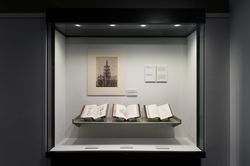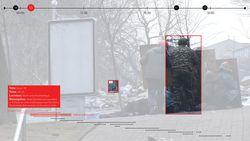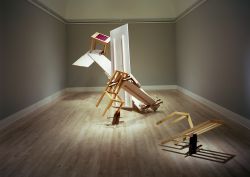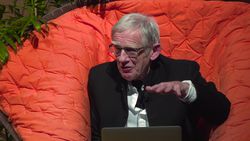dessins
Quantité:
37 design development drawing(s)
Set of numbered drawings
AP140.S2.SS1.D31.P3
Description:
set of numbered drawings (dated September 1966) showing floor plans (including a basement plan with underground parking garage and ramp), cross sections, a longitudinal section, a bird's-eye plan oblique, and plans for typical furnished students' rooms; includes sets of drawings and sketches comprising floor plans and cross sections, a cross section and ground floor plan (dated February 1967) showing a parking garage below the modified A-frames, a few preliminary plans and cross sections at a larger scale, and preliminary plans for typical furnished students' rooms; there is a group of design development drawings (dated June 1967) on a larger format of paper, consisting of floor plans, plans for typical furnished students' rooms, cross sections, a partial section, longitudinal sections, elevations, and sectional elevations, and there is a bird's-eye plan oblique (dated September 1967)
1966-1967
Set of numbered drawings
Actions:
AP140.S2.SS1.D31.P3
Description:
set of numbered drawings (dated September 1966) showing floor plans (including a basement plan with underground parking garage and ramp), cross sections, a longitudinal section, a bird's-eye plan oblique, and plans for typical furnished students' rooms; includes sets of drawings and sketches comprising floor plans and cross sections, a cross section and ground floor plan (dated February 1967) showing a parking garage below the modified A-frames, a few preliminary plans and cross sections at a larger scale, and preliminary plans for typical furnished students' rooms; there is a group of design development drawings (dated June 1967) on a larger format of paper, consisting of floor plans, plans for typical furnished students' rooms, cross sections, a partial section, longitudinal sections, elevations, and sectional elevations, and there is a bird's-eye plan oblique (dated September 1967)
dessins
Quantité:
37 design development drawing(s)
1966-1967
dessins
DR1988:0433:027
Description:
- Drawing showing designs for four different types of dormer windows of Fonthill House, Wiltshire. Two windows have triangular pediments, while the others have semi-circular pediments. - One of a group of working drawings for William Burn's October 1849 project for Fonthill House, Wiltshire, a country house designed in the Jacobethan style. This group represents only one of the projects that Burn proposed for Fonthill House; the final project, executed in 1856, was much smaller (Walker, 31, illustrated in Hitchcock, vol. 2, fig. VIII 31). Drawings include plans, elevations, and sections, as well as full-scale drawings of masonry details. Approximately half of the drawings are part of a numbered series from one to twenty-two, while the other drawings, mostly masonry details, were not numbered. These latter drawings are not as carefully finished, and a few are incomplete.
architecture
October 1849
Elevations and profiles for four types of dormer windows for Fonthill House
Actions:
DR1988:0433:027
Description:
- Drawing showing designs for four different types of dormer windows of Fonthill House, Wiltshire. Two windows have triangular pediments, while the others have semi-circular pediments. - One of a group of working drawings for William Burn's October 1849 project for Fonthill House, Wiltshire, a country house designed in the Jacobethan style. This group represents only one of the projects that Burn proposed for Fonthill House; the final project, executed in 1856, was much smaller (Walker, 31, illustrated in Hitchcock, vol. 2, fig. VIII 31). Drawings include plans, elevations, and sections, as well as full-scale drawings of masonry details. Approximately half of the drawings are part of a numbered series from one to twenty-two, while the other drawings, mostly masonry details, were not numbered. These latter drawings are not as carefully finished, and a few are incomplete.
dessins
October 1849
architecture
L’anatomie du livre d’architecture, une exposition présentée dans le cadre du lancement de The Anatomy of the Architectural Book d’ André Tavares, traite de la relation entre la culture du livre et celle du bâtiment, mettant au jour les axes de diffusion de la connaissance architecturale, qui vont du livre au bâti et vice-versa. À travers sept thèmes – texture, mise en(...)
10 mai 2016 au 20 novembre 2016
L’anatomie du livre d’architecture
Actions:
Description:
L’anatomie du livre d’architecture, une exposition présentée dans le cadre du lancement de The Anatomy of the Architectural Book d’ André Tavares, traite de la relation entre la culture du livre et celle du bâtiment, mettant au jour les axes de diffusion de la connaissance architecturale, qui vont du livre au bâti et vice-versa. À travers sept thèmes – texture, mise en(...)
Série(s)
AP193.S1
Description:
Series 1, Water Flux and Scrambled Flat, 2002-2010, documents the conception and evolution of a project that was originally a farm building and later became a geology and glaciology museum and research center focused on the Swiss Alps. The project was never realized. R&Sie(n) conceptualized Scrambled Flat as an experimental farm. The project goal was to reconcile European Union’s agricultural regulations, imposing a separation between animal and human living, to the community of Évolène traditional way of living, contiguously with animals, benefiting from the resources they offer. As conceived, Scrambled Flat creates an environment where fluidity between the existence of the animals and the humans is materialized. The size of the form is also adapted from a typical local rural house and exploits the heat of the animals and the insulation of the hay. For this project, R&Sie(n) approached the mayor of the community with the design proposition. The mayor then called for a competition, while also changing the program to an ecology museum and research center illustrating the local effects of global warming and the thawing of the Alps. R&Sie(n) won the competition with Water Flux, a reinterpretation of Scrambled Flat. The project was intended to uncover and exorcise the anxieties of ecological disaster, and the principle of flux related to seasonal change and, more broadly, climate change. The firm designed rooms that reproduce the geological and meteorological environment of the high mountains making it visible and experimental, offering refrigerated spaces for art installations and scientific demonstrations. The concept was also to build with the use of new technologies such as digital modelling, point scanning, and computer numerical control (CNC), combined with ancient local knowledge of knocking on trees to decide which specific pines have the best wood for construction. The building is designed to be constructed with local lamellar wood milled by nearby CNC. The resulting parts would be used for the structure, the insulation, the waterproofing and both the interior and exterior finishes. The design includes a grille wrapping the building, reproducing the profile of traditional houses and enclosure and making it possible to hold the snow inside a typo-morphological imprint. Therefore, the transformable envelope of the building reacts to the rhythm of the seasons. In the winter, the structure would appear like a solid cut-out of ice and snow, with cavities similar to those found in glaciers. In the summer, it would resemble piles of stones used in these areas to make borders. A small pool would collect rainwater and supply it to an interior artificial snowmaking system designed for the gallery. Transformation of the water is an integral part of the design. The records contain images of plans, sections, details for the structure of the façade, renderings, plans of the engineered structure, and photographs documenting the conception of the models with the CNC machinery. The Rhino 3D modelling files are also part of the records along with AutoCAD models and a video documenting the process. The records contain two physical models: a smaller polymer model at 1:20 scale representing the whole structure of the building, and a larger 1:1 latch wood fragment representing detail of the structure in its integrality.
2002-2010
Water Flux and Scrambled Flat
Actions:
AP193.S1
Description:
Series 1, Water Flux and Scrambled Flat, 2002-2010, documents the conception and evolution of a project that was originally a farm building and later became a geology and glaciology museum and research center focused on the Swiss Alps. The project was never realized. R&Sie(n) conceptualized Scrambled Flat as an experimental farm. The project goal was to reconcile European Union’s agricultural regulations, imposing a separation between animal and human living, to the community of Évolène traditional way of living, contiguously with animals, benefiting from the resources they offer. As conceived, Scrambled Flat creates an environment where fluidity between the existence of the animals and the humans is materialized. The size of the form is also adapted from a typical local rural house and exploits the heat of the animals and the insulation of the hay. For this project, R&Sie(n) approached the mayor of the community with the design proposition. The mayor then called for a competition, while also changing the program to an ecology museum and research center illustrating the local effects of global warming and the thawing of the Alps. R&Sie(n) won the competition with Water Flux, a reinterpretation of Scrambled Flat. The project was intended to uncover and exorcise the anxieties of ecological disaster, and the principle of flux related to seasonal change and, more broadly, climate change. The firm designed rooms that reproduce the geological and meteorological environment of the high mountains making it visible and experimental, offering refrigerated spaces for art installations and scientific demonstrations. The concept was also to build with the use of new technologies such as digital modelling, point scanning, and computer numerical control (CNC), combined with ancient local knowledge of knocking on trees to decide which specific pines have the best wood for construction. The building is designed to be constructed with local lamellar wood milled by nearby CNC. The resulting parts would be used for the structure, the insulation, the waterproofing and both the interior and exterior finishes. The design includes a grille wrapping the building, reproducing the profile of traditional houses and enclosure and making it possible to hold the snow inside a typo-morphological imprint. Therefore, the transformable envelope of the building reacts to the rhythm of the seasons. In the winter, the structure would appear like a solid cut-out of ice and snow, with cavities similar to those found in glaciers. In the summer, it would resemble piles of stones used in these areas to make borders. A small pool would collect rainwater and supply it to an interior artificial snowmaking system designed for the gallery. Transformation of the water is an integral part of the design. The records contain images of plans, sections, details for the structure of the façade, renderings, plans of the engineered structure, and photographs documenting the conception of the models with the CNC machinery. The Rhino 3D modelling files are also part of the records along with AutoCAD models and a video documenting the process. The records contain two physical models: a smaller polymer model at 1:20 scale representing the whole structure of the building, and a larger 1:1 latch wood fragment representing detail of the structure in its integrality.
Series
2002-2010
dessins
DR1981:0024
Description:
- DR1981:0024 shows a design for what appears to be an ornamental footbridge. No dimensions are given and materials are not indicated, but the structure could not have been erected at a very large scale. The road bed consists of three sections: a central flat section supported on a broad flat arch; and two gently-sloped side sections, each supported on seven small, round-headed arches. The span of the bridge is braced between two sets of double piers. Each of these four piers carries an octagonal kiosk consisting of closed panels below and an open framework above. At the centre of the bridge rises a pavilion formed of sixteen columns on a rectangular plan (six columns on each of the two long sides) supporting a curved gable roof. Above the road bed, the superstructure is decorated with banners, lanterns, fretwork, and inscriptions, all in a style of Chinese derivation.
architecture, architecture de paysage
ca. 1763
Design for a bridge in the Chinese style to be erected at Sanssouci
Actions:
DR1981:0024
Description:
- DR1981:0024 shows a design for what appears to be an ornamental footbridge. No dimensions are given and materials are not indicated, but the structure could not have been erected at a very large scale. The road bed consists of three sections: a central flat section supported on a broad flat arch; and two gently-sloped side sections, each supported on seven small, round-headed arches. The span of the bridge is braced between two sets of double piers. Each of these four piers carries an octagonal kiosk consisting of closed panels below and an open framework above. At the centre of the bridge rises a pavilion formed of sixteen columns on a rectangular plan (six columns on each of the two long sides) supporting a curved gable roof. Above the road bed, the superstructure is decorated with banners, lanterns, fretwork, and inscriptions, all in a style of Chinese derivation.
dessins
ca. 1763
architecture, architecture de paysage
Le rôle élargi: SITU
Bradley Samuels présente le travail récent de SITU Research et le rôle joué par la recherche au sein de la pratique de SITU dans son ensemble. Une série d’études de cas sera présentée, explorant le rôle élargi de la pratique architecturale et spatiale à travers un éventail de domaines, des droits humains à la politique publique, de la science de la terre au design(...)
Théâtre Paul-Desmarais
14 janvier 2016
Le rôle élargi: SITU
Actions:
Description:
Bradley Samuels présente le travail récent de SITU Research et le rôle joué par la recherche au sein de la pratique de SITU dans son ensemble. Une série d’études de cas sera présentée, explorant le rôle élargi de la pratique architecturale et spatiale à travers un éventail de domaines, des droits humains à la politique publique, de la science de la terre au design(...)
Théâtre Paul-Desmarais
Paraboles et autres allégories : L’Œuvre de Melvin Charney 1975-1990 présente une centaine de dessins, dont plusieurs à grande échelle, des esquisses, des photographies, ainsi que trois grandes constructions. Réunissant des pièces issues de diverses collections publiques et privées, dont celle du CCA, l’exposition permet une analyse globale de la démarche artistique de(...)
Salles principales
9 octobre 1991 au 12 janvier 1992
Paraboles et autres allégories : L'oeuvre de Melvin Charney, 1975-1990
Actions:
Description:
Paraboles et autres allégories : L’Œuvre de Melvin Charney 1975-1990 présente une centaine de dessins, dont plusieurs à grande échelle, des esquisses, des photographies, ainsi que trois grandes constructions. Réunissant des pièces issues de diverses collections publiques et privées, dont celle du CCA, l’exposition permet une analyse globale de la démarche artistique de(...)
Salles principales
Les individus agissent comme leurs propres historiens, en masquant certaines histoires et en mettant l’accent sur d’autres. Mais à l’échelle des nations et des cultures, et surtout dans cette époque de la mémoire numérique omniprésente, il est devenu plus difficile d’oublier. S’appuyant sur la question de l’histoire et de ses usages, soulevée par des expositions comme(...)
7 décembre 2017
Venez oublier l’Internet, avec Evgueny Morozov
Actions:
Description:
Les individus agissent comme leurs propres historiens, en masquant certaines histoires et en mettant l’accent sur d’autres. Mais à l’échelle des nations et des cultures, et surtout dans cette époque de la mémoire numérique omniprésente, il est devenu plus difficile d’oublier. S’appuyant sur la question de l’histoire et de ses usages, soulevée par des expositions comme(...)
Les individus agissent comme leurs propres historiens, en masquant certaines histoires et en mettant l’accent sur d’autres. Mais à l’échelle des nations et des cultures, et surtout dans cette époque de la mémoire numérique omniprésente, il est devenu plus difficile d’oublier. S’appuyant sur la question de l’histoire et de ses usages, soulevée par des expositions comme(...)
Craig Hodgetts
29 mars 2018
Venez oublier la grille, avec Craig Hodgetts
Actions:
Description:
Les individus agissent comme leurs propres historiens, en masquant certaines histoires et en mettant l’accent sur d’autres. Mais à l’échelle des nations et des cultures, et surtout dans cette époque de la mémoire numérique omniprésente, il est devenu plus difficile d’oublier. S’appuyant sur la question de l’histoire et de ses usages, soulevée par des expositions comme(...)
Craig Hodgetts
Les individus agissent comme leurs propres historiens, en masquant certaines histoires et en mettant l’accent sur d’autres. Mais à l’échelle des nations et des cultures, et surtout dans cette époque de la mémoire numérique omniprésente, il est devenu plus difficile d’oublier. S’appuyant sur la question de l’histoire et de ses usages, soulevée par des expositions comme(...)
Johannes Grenzfurthner
12 avril 2018
Venez oublier la contre-culture, avec Johannes Grenzfurthner
Actions:
Description:
Les individus agissent comme leurs propres historiens, en masquant certaines histoires et en mettant l’accent sur d’autres. Mais à l’échelle des nations et des cultures, et surtout dans cette époque de la mémoire numérique omniprésente, il est devenu plus difficile d’oublier. S’appuyant sur la question de l’histoire et de ses usages, soulevée par des expositions comme(...)
Johannes Grenzfurthner





